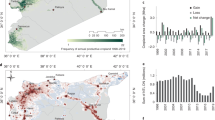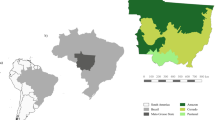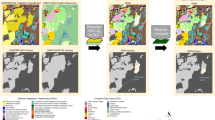Abstract
Armed conflicts often hinder food security through cropland abandonment and restrict the collection of on-the-ground information required for targeted relief distribution. Satellite remote sensing provides a means for gathering information about disruptions during armed conflicts and assessing the food security status in conflict zones. Using ~7,500 multisource satellite images, we implemented a data-driven approach that showed a reduction in cultivated croplands in war-ravaged South Sudan by 16% from 2016 to 2018. Propensity score matching revealed a statistical relationship between cropland abandonment and armed conflicts that contributed to drastic decreases in food supply. Our analysis shows that the abandoned croplands could have supported at least a quarter of the population in the southern states of South Sudan and demonstrates that remote sensing can play a crucial role in the assessment of cropland abandonment in food-insecure regions, thereby improving the basis for timely aid provision.
This is a preview of subscription content, access via your institution
Access options
Access Nature and 54 other Nature Portfolio journals
Get Nature+, our best-value online-access subscription
$29.99 / 30 days
cancel any time
Subscribe to this journal
Receive 12 digital issues and online access to articles
$119.00 per year
only $9.92 per issue
Buy this article
- Purchase on Springer Link
- Instant access to full article PDF
Prices may be subject to local taxes which are calculated during checkout


Similar content being viewed by others
Data availability
The intermediate data that support the findings of this study are available at https://doi.org/10.17894/ucph.5e12bdda-b2d7-4835-8ae1-a7c49affb97b. Source data are provided with this paper. Land-cover training and validation data are available on request.
Code availability
Code used for land-cover classification in GEE and propensity score analysis are available at https://github.com/victor-m-olsen/nature-food.
Change history
11 January 2022
A Correction to this paper has been published: https://doi.org/10.1038/s43016-022-00459-1
References
Assessing Cropland Abandonment in Mopti Region with Satellite Imagery (WFP, 2019).
Baumann, M., Radeloff, V. C., Avedian, V. & Kuemmerle, T. Land-use change in the Caucasus during and after the Nagorno-Karabakh conflict. Reg. Environ. Change 15, 1703–1716 (2015).
Hendrix, C. & Brinkman, H.-J. Food insecurity and conflict dynamics: causal linkages and complex feedbacks. Stabil. Int. J. Secur. Dev. 2, 26 (2013).
The State of Food Security and Nutrition in the World 2018: Building Climate Resilience for Food Security and Nutrition (FAO, 2018).
Tong, X. et al. Revisiting the coupling between NDVI trends and cropland changes in the Sahel drylands: a case study in western Niger. Remote Sens. Environ. 191, 286–296 (2017).
Prishchepov, A. V. Agricultural Land Abandonment (Oxford Bibliographies, 2020).
Witmer, F. D. W. Detecting war‐induced abandoned agricultural land in northeast Bosnia using multispectral, multitemporal Landsat TM imagery. Int. J. Remote Sens. 29, 3805–3831 (2008).
Eklund, L., Degerald, M., Brandt, M., Prishchepov, A. V. & Pilesjö, P. How conflict affects land use: agricultural activity in areas seized by the Islamic State. Environ. Res. Lett. 12, 054004 (2017).
Skakun, S., Justice, C. O., Kussul, N., Shelestov, A. & Lavreniuk, M. Satellite data reveal cropland losses in South-Eastern Ukraine under military conflict. Front. Earth Sci. 7, 305 (2019).
Yin, H. et al. Monitoring cropland abandonment with Landsat time series. Remote Sens. Environ. 246, 111873 (2020).
Blair, D., Shackleton, C. M. & Mograbi, P. J. Cropland abandonment in South African smallholder communal lands: land cover change (1950–2010) and farmer perceptions of contributing factors. Land 7, 121 (2018).
Prishchepov, A. V., Schierhorn, F. & Löw, F. Unraveling the diversity of trajectories and drivers of global agricultural land abandonment. Land 10, 97 (2021).
Næss, J. S., Cavalett, O. & Cherubini, F. The land–energy–water nexus of global bioenergy potentials from abandoned cropland. Nat. Sustain. 4, 525–536 (2021).
Raj Khanal, N. & Watanabe, T. Abandonment of agricultural land and its consequences. Mt. Res. Dev. 26, 32–40 (2006).
Baiphethi, M. N. & Jacobs, P. T. The contribution of subsistence farming to food security in South Africa. Agric. Econ. Res. Policy Pract. South Africa 48, 459–482 (2005).
Yin, H. et al. Agricultural abandonment and re-cultivation during and after the Chechen Wars in the northern Caucasus. Global Environ. Change 55, 149–159 (2019).
The State of Food Security and Nutrition in the World 2017 (FAO, 2017).
Special Report: Crop and Food Security Assessment Mission to South Sudan, March 2018 (FAO, 2018).
Battersby, J. & Watson, V. Addressing food security in African cities. Nat. Sustain. 1, 153–155 (2018).
Samasse, K., Hanan, N. P., Anchang, J. Y. & Diallo, Y. A high-resolution cropland map for the West African Sahel based on high-density training data, Google Earth Engine, and locally optimized machine learning. Remote Sensing 12, 1436 (2020).
Somanathan, E., Prabhakar, R. & Mehta, B. S. Decentralization for cost-effective conservation. Proc. Natl Acad. Sci. USA 106, 4143–4147 (2009).
Rosenbaum, P. R. & Rubin, D. B. The central role of the propensity score in observational studies for causal effects. Biometrika 70, 41–55 (1983).
FoodData Central (USDA, 06/13/2020); https://fdc.nal.usda.gov/index.html
Baumann, M. & Kuemmerle, T. The impacts of warfare and armed conflict on land systems. J. Land Use Sci. 11, 672–688 (2016).
Bégué, A. et al. Remote sensing and cropping practices: a review. Remote Sensing 10, 99 (2018).
Valero, S. et al. Production of a dynamic cropland mask by processing remote sensing image series at high temporal and spatial resolutions. Remote Sens. 8, 55 (2016).
Carrasco, L., O’Neil, A. W., Daniel Morton, R. & Rowland, C. S. Evaluating combinations of temporally aggregated Sentinel-1, Sentinel-2 and Landsat 8 for land cover mapping with Google Earth Engine. Remote Sens. 11, 288 (2019).
Moreno-Martínez, Á. et al. Interpolation and gap filling of Landsat reflectance time series. In Proc. IEEE International Geoscience Remote Sensing Symposium 2018, 349–352 (IEEE, 2018).
Special Report: Crop and Food Security Assessment Mission to South Sudan, March 2019 (FAO, 2019).
Ray, D. K. et al. Climate change has likely already affected global food production. PLoS ONE 14, e0217148 (2019).
Schleussner, C.-F., Donges, J. F., Donner, R. V. & Schellnhuber, H. J. Armed-conflict risks enhanced by climate-related disasters in ethnically fractionalized countries. Proc. Natl Acad. Sci. USA 113, 9216–9221 (2016).
Mach, K. J. et al. Climate as a risk factor for armed conflict. Nature 571, 193–197 (2019).
Benayas, J. R., Martins, A., Nicolau, J. M. & Schulz, J. J. Abandonment of agricultural land: an overview of drivers and consequences. CAB Rev. 2, 057 (2007).
Kamp, J. Weighing up reuse of Soviet croplands. Nature 505, 483 (2014).
Schiermeier, Q. Soviet Union’s collapse led to massive drop in carbon emissions. Nature https://doi.org/10.1038/d41586-019-02024-6 (2019).
Huang, X., Ziniti, B. & Torbick, N. Assessing conflict driven food security in Rakhine, Myanmar with multisource imagery. Land 8, 95 (2019).
Chaudhary, S. et al. A synopsis of farmland abandonment and its driving factors in Nepal. Land 9, 84 (2020).
Special Report: Crop and Food Security Assessment Mission to South Sudan (FAO, 2017).
Gorelick, N. et al. Google Earth Engine: planetary-scale geospatial analysis for everyone. Remote Sens. Environ. 202, 18–27 (2017).
Murphy, S. Cloud masking of Sentinel 2 using Google Earth Engine (GitHub, 2018); https://github.com/samsammurphy/cloud-masking-sentinel2
Technical Guide: Cloud Masks (ESA, 2019); https://sentinel.esa.int/web/sentinel/technical-guides/sentinel-2-msi/level-1c/cloud-masks
Phalke, A. R. & Özdoğan, M. Large area cropland extent mapping with Landsat data and a generalized classifier. Remote Sens. Environ. 219, 180–195 (2018).
Inglada, J., Vincent, A., Arias, M. & Marais-Sicre, C. Improved early crop type identification by joint use of high temporal resolution SAR and optical image time series. Remote Sens. 8, 362 (2016).
Van Tricht, K., Gobin, A., Gilliams, S. & Piccard, I. Synergistic use of radar Sentinel-1 and optical Sentinel-2 imagery for crop mapping: a case study for Belgium. Remote Sens. 10, 1642 (2018).
sklearn.feature_selection.RFECV (SciKit, 2019); https://scikit-learn.org/stable/modules/generated/sklearn.feature_selection.RFECV.html
Olofsson, P. et al. Good practices for estimating area and assessing accuracy of land change. Remote Sens. Environ. 148, 42–57 (2014).
Olofsson, P. et al. Mitigating the effects of omission errors on area and area change estimates. Remote Sens. Environ. 236, 111492 (2020).
Hu, T., Liu, J., Zheng, G., Li, Y. & Xie, B. Quantitative assessment of urban wetland dynamics using high spatial resolution satellite imagery between 2000 and 2013. Sci. Rep. 8, 7409 (2018).
Zhou, H. et al. Monitoring the change of urban wetland using high spatial resolution remote sensing data. Int. J. Remote Sens. 31, 1717–1731 (2010).
Yuan, F., Sawaya, K. E., Loeffelholz, B. C. & Bauer, M. E. Land cover classification and change analysis of the Twin Cities (Minnesota) Metropolitan Area by multitemporal Landsat remote sensing. Remote Sens. Environ. 98, 317–328 (2005).
Prishchepov, A. A., Müller, D., Dubinin, M., Baumann, M. & Radeloff, V. C. Determinants of agricultural land abandonment in post-Soviet European Russia. Land Use Policy 30, 873–884 (2013).
Wilson, S. A. & Wilson, C. O. Modelling the impacts of civil war on land use and land cover change within Kono District, Sierra Leone: a socio-geospatial approach. Geocarto Int. 28, 476–501 (2013).
Sieber, A. et al. Landsat-based mapping of post-Soviet land-use change to assess the effectiveness of the Oksky and Mordovsky protected areas in European Russia. Remote Sens. Environ. 133, 38–51 (2013).
South Sudan—County Population Estimates—2015–2020 (HDX, 2019); https://data.humdata.org/dataset/south-sudan-county-population-estimates-2015-2020
About ACLED (ACLED, 2019); https://www.acleddata.com/about-acled/
Raleigh, C., Linke, A., Hegre, H. & Karlsen, J. Introducing ACLED: an armed conflict location and event dataset. J. Peace Res. 47, 651–660 (2010).
Donnay, K., Dunford, E. T., McGrath, E. C., Backer, D. & Cunningham, D. E. Integrating conflict event data. J. Conflict Resolut. 63, 1337–1364 (2019).
Eck, K. In data we trust? A comparison of UCDP GED and ACLED conflict events datasets. Coop. Confl. 47, 124–141 (2012).
Raleigh, C. & Dowd, C. Armed Conflict Location and Event Data Project (ACLED) Codebook (ACLED, 2015).
Funk, C. et al. The climate hazards infrared precipitation with stations—a new environmental record for monitoring extremes. Sci. Data 2, 150066 (2015).
Gellrich, M., Baur, P., Koch, B. & Zimmermann, N. E. Agricultural land abandonment and natural forest re-growth in the Swiss mountains: a spatially explicit economic analysis. Agric. Ecosyst. Environ. 118, 93–108 (2007).
Ho, D. E., Imai, K., King, G. & Stuart, E. A. MatchIt 804, 495–2027 (2011).
Caliendo, M. & Kopeinig, S. Some practical guidance for the implementation of propensity score matching. J. Econ. Surv. 22, 31–72 (2008).
Special Report: Crop and Food Security Assessment Mission to South Sudan, February 2016 (FAO, 2016).
Special Report: Crop and Food Security Assessment Mission to South Sudan, February 2014 (FAO, 2014).
Special Report: Crop and Food Security Assessment Mission to South Sudan, May 2015 (FAO, 2015).
FAOSTAT. Data. Trade. Crops and Livestock Products (FAO, 2020); http://faostat3.fao.org/browse/T/TP/E
Food and Nutrition Security Assessment in Sudan: Analysis of 2009 National Baseline Household Survey (SIFSIA, 2010).
Buchhorn, M. et al. Copernicus Global Land Service: Land Cover 100m: Version 3 Globe 2015–2019: Product User Manual (Zenodo, 2020); https://zenodo.org/record/3938963
Acknowledgements
We acknowledge the support of DFF-Danish ERC Support Program (grant number 116491, 9127-00001B). The funders had no role in study design, data collection and analysis, decision to publish or preparation of the manuscript. We also acknowledge the WFP for providing in situ data for the study. Finally, we acknowledge the contribution of N. Keuler from the University of Wisconsin-Madison for consultation on statistical analysis.
Author information
Authors and Affiliations
Contributions
V.O. conducted all analyses in this research and drafted the paper. A.P. and R.F. supervised the work, revised the paper and provided technical and thematic insights. Additionally, A.P. conducted the analysis on kilocalorie availability. P.O. and D.D. contributed to the accuracy assessment. R.B. provided field data and revised the paper. V.B. supervised the econometric analysis. D.R. contributed to the food security narrative. All authors edited, reviewed and approved the final manuscript.
Corresponding author
Ethics declarations
Competing interests
The authors declare no competing interests.
Additional information
Peer review information Nature Food thanks Manfred Buchroithner and the other, anonymous, reviewer(s) for their contribution to the peer review of this work.
Publisher’s note Springer Nature remains neutral with regard to jurisdictional claims in published maps and institutional affiliations.
Supplementary information
Supplementary Information
Supplementary Figs. 1 and 2 and Tables 1–17.
Source data
Source Data Fig. 2
Calculation on missed crop production and kilocalories.
Rights and permissions
About this article
Cite this article
Olsen, V.M., Fensholt, R., Olofsson, P. et al. The impact of conflict-driven cropland abandonment on food insecurity in South Sudan revealed using satellite remote sensing. Nat Food 2, 990–996 (2021). https://doi.org/10.1038/s43016-021-00417-3
Received:
Accepted:
Published:
Issue Date:
DOI: https://doi.org/10.1038/s43016-021-00417-3
This article is cited by
-
Agricultural land abandonment promotes soil aggregation and aggregate-associated organic carbon accumulation: a global meta-analysis
Plant and Soil (2024)
-
The neglected role of abandoned cropland in supporting both food security and climate change mitigation
Nature Communications (2023)
-
Risk assessment and validation of farmland abandonment based on time series change detection
Environmental Science and Pollution Research (2023)
-
Determinants of farmland abandonment in the urban–rural fringe of Ghana
Regional Environmental Change (2023)
-
Crop harvests for direct food use insufficient to meet the UN’s food security goal
Nature Food (2022)



